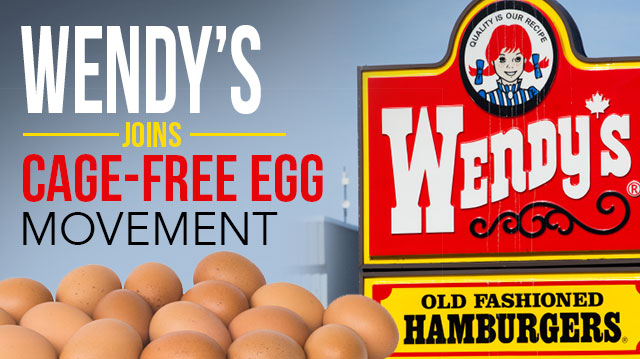
On January 4, 2016, Wendy’s announced its transition to using 100 percent cage-free eggs in all North American locations by 2020, according to a press release.
Wendy’s has joined other fast food restaurant chains, including Panera, Nestlé, Starbucks, and Costco, in the cage-free egg movement. McDonald’s and Subway have committed to a 2025 deadline for a cage-free transition.
In October 2015, 6.66 billion eggs were produced in the United States, according to the American Egg Board. Presently, there are 63 egg-producing companies with more than one million hens per company, and 17 companies with more than five million hens per company.
According to the American Egg Board: “As of September 2015, the total US Cage-Free Flock totaled 8.6 percent, or 23.6 million hens. Of this figure, 4.2 percent, 11.4 million hens, were USDA Organic, and 4.5 percent, 12.2 million hens, were Other Cage-Free.”
Taking the necessary strides toward a cage-free egg-producing America may be the more humane approach to enjoying a morning McMuffin (though it’s obviously not a healthy breakfast!). Wendy’s serves eggs with the bulk of their breakfast menu items, but the number of eggs still remains unclear.
Liliana Esposito, Wendy’s chief communications officer, said in the press release: “We’re proud of our commitment to move to 100 percent cage-free eggs for our breakfast items and will continue to incorporate evolving best practices in the areas of animal handling and welfare into our supply chain requirements.”
Developing more humane practices and adopting an ethical standard is wonderful to see from American companies. However, their motivations may be merely another marketing campaign to attract consumers to order counters. Fast food chains, such as Wendy’s, have been experiencing revenue woes as many American consumers have turned toward ordering health over convenience. Wendy’s revenue dropped from $2.49 billion in 2013 to $2.06 billion in 2014, according to MarketWatch financial reports. McDonald’s revenue dropped nearly $1 billion from 2013 to 2014, according to reports.
Are cage-free practices all that much better? Although the cage-free movement is an excellent first step, cage-free egg production poses comparable complications for the millions of hens producing the key ingredient Americans enjoy in their breakfast sandwiches.
 It is important to keep in mind that cage-free does not equate to hens wandering beautiful green pastures or vast open rooms illuminated by sunlight and fresh air. According to Mercy For Animals, cage-free areas are overcrowded, hens have no access to outdoors and they undergo beak mutilation. Also, male chicks and unusable hens remain victims to macerators and violent slaughter, according to Mercy For Animals.
It is important to keep in mind that cage-free does not equate to hens wandering beautiful green pastures or vast open rooms illuminated by sunlight and fresh air. According to Mercy For Animals, cage-free areas are overcrowded, hens have no access to outdoors and they undergo beak mutilation. Also, male chicks and unusable hens remain victims to macerators and violent slaughter, according to Mercy For Animals.
For the most humane eggs, your best bet is a local farmer who uses organic practices, allows their chickens room to peck and forage outside, and houses them in non-confined indoor areas. Get to know some farmers in your area, get to know their practices and you’ll soon be enjoying the most humane eggs possible.
Where do you get your eggs?
-Stephen Seifert
Stephen Seifert is a writer, professor, adventurer and a health & fitness guru. His flair for travel and outdoor adventure allows him to enjoy culture and traditions different than his own. A healthy diet, routine fitness and constant mental development is the cornerstone to Stephen’s life.
Sources:
http://ir.wendys.com/phoenix.zhtml?c=67548&p=irol-newsArticle&ID=2125839
http://www.aeb.org/farmers-and-marketers/industry-overview
http://www.marketwatch.com/investing/stock/wen/financials
http://www.marketwatch.com/investing/stock/mcd/financials/balance-sheet
http://www.mfablog.org/5-reasons-cage-free-isnt-what-you-think

